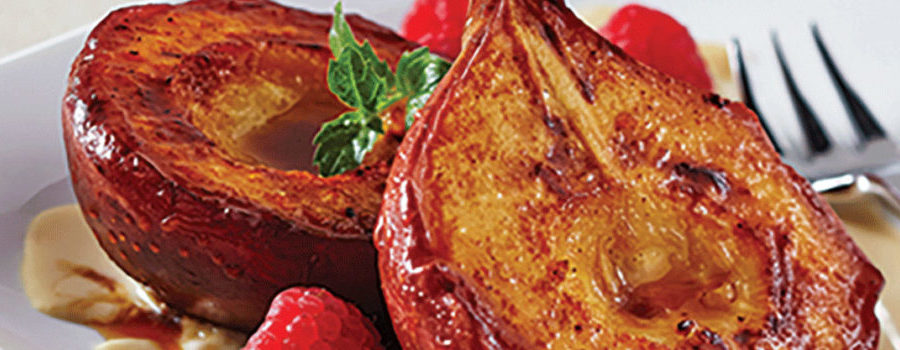Roasting elevates fruits and vegetables, bringing out their natural sweetness. The oven’s heat evaporates the water, reducing any bitterness and leaving behind rich caramelization and a hearty texture. Our expert guide will help you roast the classics (potatoes and apples) and experiment with new flavours (mangoes and green onions) with confidence.
Pick It
Almost any hardy fruit or vegetable can be roasted. Traditional fruit options include firm varieties with cores, such as apples, pears, plums and peaches. Root and cruciferous veggies, like potatoes, carrots, Brussels sprouts and cauliflower, are also popular. But more tender produce – tropical fruits, grapes, bananas, delicate kale, green onions, asparagus – benefits from roasting as well.
You can also roast many kinds of nuts; try walnuts, peanuts, almonds or your favourite variety. If the nuts you’re using have the skins on (such as hazelnuts) and you’d prefer not to eat them, remove the skins quickly by placing the cooled roasted nuts on a clean tea towel and rubbing vigorously.
Choose wisely: Fruits and veggies used for roasting should be ripe yet firm. If they’re too soft, they will simply become mushy and lose their shape instead of developing a flavourful brown exterior.
Prep It
What You’ll Need
The only equipment necessary for roasting fruits and vegetables is a baking sheet or low-sided roasting pan. It doesn’t matter what kind of material it’s made of, as long as it’s large enough to accommodate everything without overcrowding.
Preparing the Produce
Prep the pan. Line a baking sheet or roasting pan with parchment paper or toss fruits and vegetables with oil to prevent the produce from sticking.
Give them space. Arrange produce evenly in the pan so that the pieces don’t touch one another, allowing about half an inch (one centimetre) in between. (Overcrowding will prevent air from circulating and inhibit browning.)
Seasoning
Put your own spin on the natural flavour of fruits and vegetables with a little olive oil plus your favourite seasonings. Tried-and-true options for veggies include garlic, or fresh or dried thyme, oregano or rosemary. Adding spice (such as vanilla, ground cinnamon, ginger, nutmeg, cloves or cardamom) boosts sweetness. If the roasted fruits or vegetables are going to accompany a savoury dish, experiment with paprika, chilies, or fennel or cumin seeds. Other great extras to liven up produce include citrus juice and zest, garlic, honey, maple syrup, wine and balsamic vinegar.
Roasting Techniques
Cook produce in the oven at a constant temperature. Roasting veggies at a high temp (400°F to 450°F/200°C to 230°C) creates a crispy, brown exterior with a soft (but not mushy) middle.
Roasting times vary depending on the size and water content of the fruit or vegetable. Starchy produce, such as pumpkins or parsnips, will take longer than non-starchy ones, such as onions and peppers. Pan-searing on the stovetop and then finishing in the oven is another option for both fruits and vegetables. Nuts can be toasted either in a dry pan on the stovetop or, for large amounts or recipes with spice, on a baking sheet in the oven.
Perfect It
Quick Fixes
- Fruits or veggies not brown enough? Place them under the broiler during the last few minutes of roasting to increase the caramelization and add lots of sweetness. Keep a close watch to ensure they don’t burn.
- For more browning, place pieces around the edges, where produce will cook faster. Similarly, place larger chunks on the outside and smaller ones in the middle for even cooking.
- Need to make a double batch? Don’t overcrowd the pan. Use two baking sheets, and halfway through cooking, switch the sheets between the racks and rotate the sheets to ensure all the vegetables brown evenly.
How to Check for Doneness
Roasted veggies and fruits should be tender but not mushy. To test for doneness, poke a few pieces with a skewer or the tip of a sharp knife. If you meet just a little resistance, it’s ready to come out of the oven. Keep an eye on roasting nuts – they can burn quickly. You’ll know the nuts are done when they begin to brown and the aroma intensifies.
Perfect Presentation
Roasted vegetables can be spread on a platter and their flavour intensified with toppings that complement the seasoning you’ve roasted them in: drizzle with oil or your favourite dressing or pesto; scatter fresh herbs or crumbled goat cheese or Parmesan overtop. And what’s roasted fruit without a scoop of ice cream or a dollop of crème fraîche or yogourt on top? Add even more flavour and sweetness with a sprinkle of cocoa, ground cinnamon or nutmeg, or a dash of honey or maple syrup.
 Back to myNiagaraOnline
Back to myNiagaraOnline
































